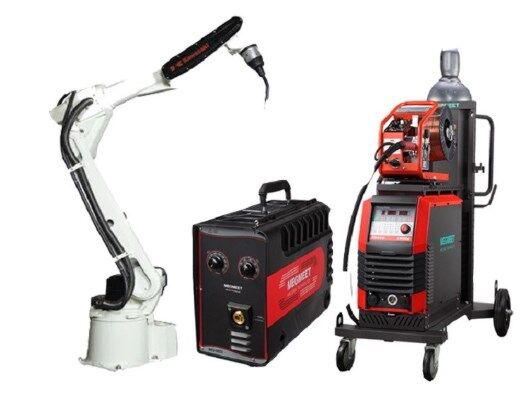I. What is Robotic Welding?
Robotic welding is an advanced manufacturing process that uses programmable industrial robots to perform welding tasks with precision and accuracy. Equipped with sensors, controllers, and specialized tools, these robots can execute repetitive tasks with minimal human intervention, making them ideal for high-volume production lines. Robot automatic welding systems are widely adopted across industries like automotive, aerospace, healthcare, and renewable energy because they improve efficiency, consistency, and safety.

Robotic automation systems can be categorized into two main types:
Fully Automated Robotic Welding: Operates independently without human intervention, ideal for large-scale production environments.
Semi-Automated Robotic Welding: Requires human assistance for tasks like loading materials or fine-tuning parameters, offering flexibility for smaller operations.
To learn Robotic Welding and complete Automation Solutions.
II. Types of Robot Automatic Welding Processes
Robotic welding can be classified into several types based on the welding technique used. Each process has unique advantages and applications, catering to specific industry needs.
1. Robotic Arc Welding (TIG, MIG, SAW)
TIG (Tungsten Inert Gas) Welding: Ideal for thin materials and precision applications, such as in aerospace and medical industries.
MIG (Metal Inert Gas) Welding: Suitable for thick metals and high-speed production, commonly used in automotive manufacturing.
SAW (Submerged Arc Welding): Used for thick steel plates and high-deposition welding in the shipbuilding and construction industries.
2. Robotic Resistance Welding
Spot Welding: Widely used in the automotive industry for joining sheet metals.
Seam Welding: Ideal for creating continuous welds in cylindrical parts, such as fuel tanks and pipes.
3. Robotic Laser Welding
A high-precision process for thin materials and complex geometries, popular in automotive and electronics manufacturing.
Laser welding is 3-4 times faster than traditional welding methods, with minimal heat input and distortion.
4. Robotic Plasma Arc Welding (PAW)
Offers high-speed, high-precision welding for applications requiring minimal distortion.
Commonly used in aerospace and medical equipment manufacturing.
5. Robotic Electron Beam Welding (EBW)
Suitable for thick materials and large-scale parts in aerospace and heavy machinery industries.
EBW is performed in a vacuum chamber, ensuring high-quality welds with minimal contamination.
III. Key Processes in Robot Automatic Welding
Robotic welding involves several critical steps to ensure precise and high-quality welds. These processes are designed to optimize efficiency and reduce human error.
Step 1: Programming
Step 2: Workpiece Preparation
Cleaning, deburring, and aligning materials are critical for achieving high-quality welds.
Step 3: Joint Tracking
Sensors and cameras track the joint location, adjusting the welding path dynamically for accurate placement.
Step 4: Welding Techniques
Selecting the right technique based on material type, thickness, and geometry ensures optimal results.
Step 5: Quality Control
Non-destructive testing (NDT) methods like ultrasonic testing, radiography, and visual inspection ensure weld integrity.
IV. Pros and Cons of Robot Automatic Welding
1. Advantages:
Higher efficiency: Robots can work continuously without breaks, increasing productivity by up to 40% compared to manual welding.
Higher consistency: Repeatable weld quality reduces defects and improves product reliability.
Safer: Robots can operate in hazardous environments, reducing workplace accidents.
Higher Precision: Ideal for complex geometries and thin materials, producing high-quality welds with minimal distortion.
Scalability: Easily scalable for high-volume production lines, making it cost-effective in the long run.
2. Disadvantages:
Higher initial cost: The upfront investment in robotic welding equipment can be prohibitive for small businesses.
Programming Complexity: Requires skilled technicians for setup and programming.
Limited Flexibility: Robots may struggle to adapt to sudden changes in production lines or materials.
Maintenance: Regular maintenance and calibration are required to ensure optimal performance.
V. Industry Applications of Robot Automatic Welding
Robotic welding has revolutionized various industries by improving production efficiency, product quality, and worker safety.

1. Automotive Industry:
Body and Chassis Welding: Robotic welding ensures high-speed assembly of vehicle bodies and chassis.
Engine and Exhaust Systems: Precision welding of critical components like engine blocks and exhaust manifolds.
2. Aerospace Industry:
3. Healthcare Industry:
Medical Devices: Sterile and precise welding of medical implants and surgical instruments.
Laboratory Equipment: Robotic welding ensures the production of high-quality, contamination-free equipment.
4. Renewable Energy:
5. Heavy Machinery:
VI. Future Trends in Robotic Welding
The robotic welding industry is evolving rapidly, with new technologies emerging to meet the demands of modern manufacturing. Here are some key trends shaping the future:
1. Integration of AI and Machine Learning:
2. Collaborative Robots (Cobots):
3. Green Welding:
4. Miniaturization and Portability:
5. Advanced Sensor Technology:
VII. FAQs About Robotic Welding
1. What industries benefit most from robotic welding?
Automotive, aerospace, healthcare, renewable energy, and electronics industries see the most benefits.
2. How does robotic welding improve safety?
By reducing human exposure to hazardous environments and automating repetitive tasks.
3. What is the average ROI for robotic welding systems?
Companies typically see a 200% ROI within 5 years due to increased efficiency and reduced labor costs.
4. Can robotic welding handle complex geometries?
Yes, advanced sensors and programming enable precise welding of complex shapes.
Robotic welding is revolutionizing modern manufacturing by combining precision, efficiency, and safety. Whether you're in automotive, aerospace, healthcare, or renewable energy, Megmeet Welding Machines offers cutting-edge robotic welding solutions tailored to your needs. Consult Megmeet's professional sales manager by clicking https://www.megmeet-welding.com/en/contacts to explore how robotic welding can transform your production line and boost your bottom line. If you want to learn more welding tips, you can read the Megmeet News Center Page or follow our LinkedIn page.
Related articles:
1. Evolution of Robot Welding: History, Impacts, Future
2. Manual Welding VS. Robot Welding
3. What is the importance of Robotic Welding Systems In Industries?
4. How to Improve Robotic Welding Performance?
5. Manual Welding VS. Robot Welding





